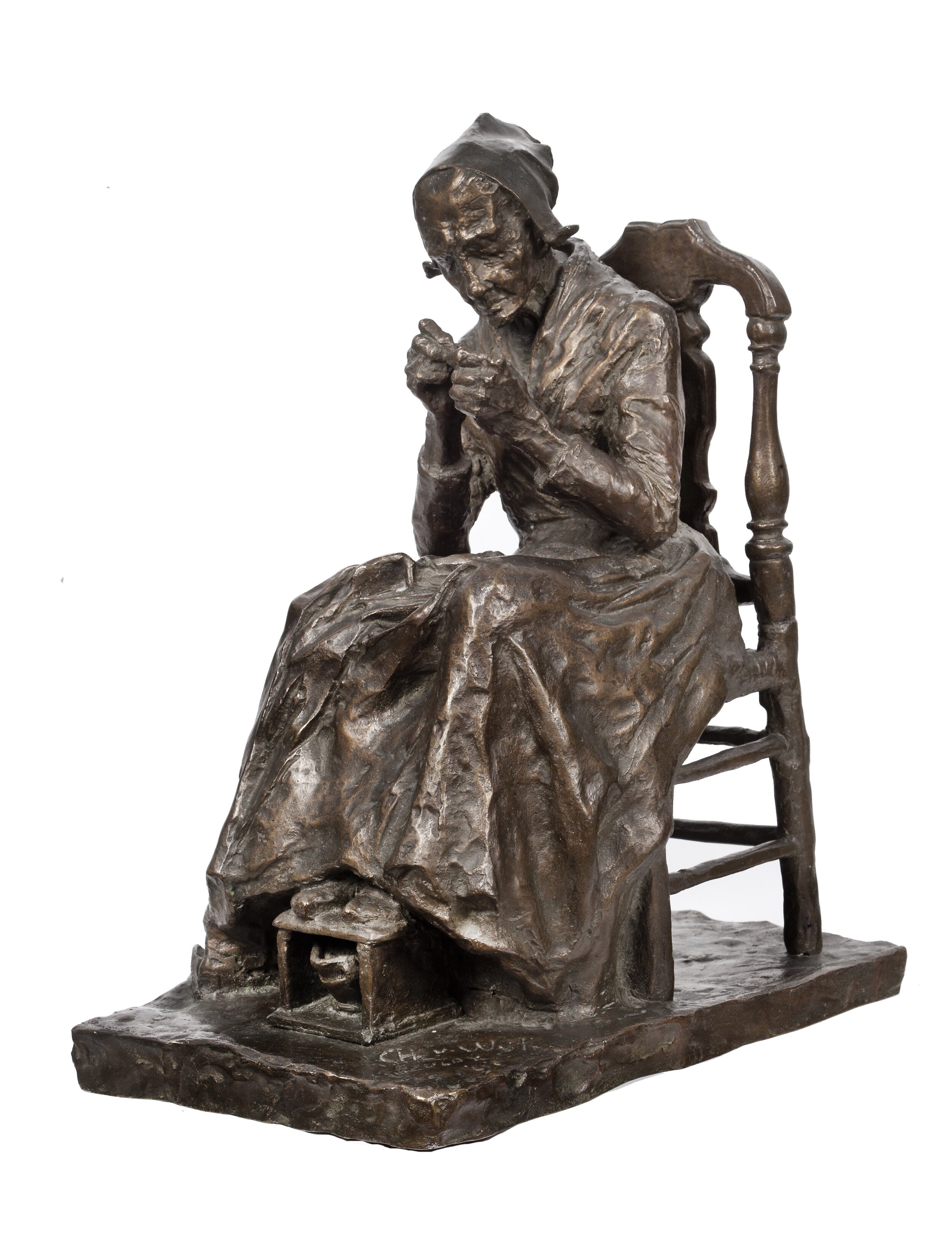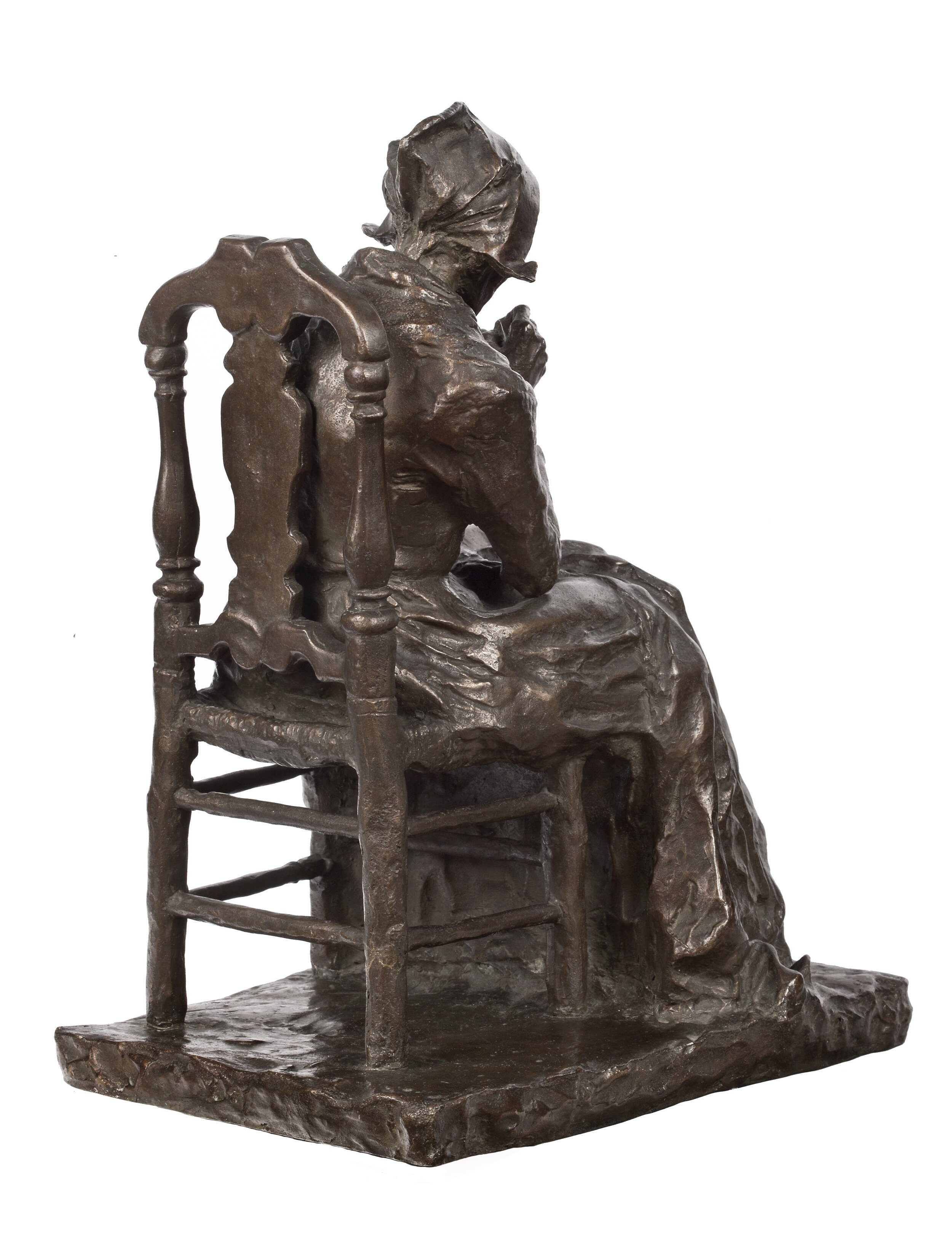

CHARLES HENRI MARIE VAN WIJK (The Hague 1875 – The Hague 1917)
Oude Vrouw haar Linnen Verstellende (Old Woman Mending her Linen)
signed, inscribed, and dated CH.V. Wyk SCULPT 9 (?) on the base
bronze, golden-brown patina
height: 15 ¼ inches (39.4 cm), width: 8 5/8 inches (22.5 cm), depth: 12 1/16 inches (31.4 cm)
PROVENANCE
Private Collection, Illinois, until 2015
RELATED LITERATURE
B.L. Voskuil, Jr., Tentoonstelling van bronzen door Charles van Wijk, Amsterdam, October 1901, no. 13, unpaginated
Frank Buffa en Zonen, Tentoonstelling van beeldhouwwerken door Charles van Wijk, Amsterdam, 1910, no. 17
Maatschappij Arti et Amicitae, Amsterdam, 1911, no. 251
Veiling Nalatenschap Charles van Wijk, Kunstzaal Kleykamp, The Hague, November 27, 1917, lot 23
Helena Stork, “Oudje (of ‘Verstelwerk’)” in Charles van Wijk, exhibition catalog, Katwijks Museum, Katwijk, July 3 - September 25, 1999, p. 67
Charles van Wijk’s (or Wyk) practical training began in the foundry of his father Henry B. van Wijk in The Hague. Van Wijk’s skills in sculpting were obvious from a young age and encouraged by his father. Drawing lessons began with his uncle Arie Stortenbeker, an amateur painter, and at the age of twelve he was enrolled at the Royal Academy of Arts in The Hague. The chief instructor was the Belgian sculptor Antoine ‘Eugene’ Lacomblé who taught Van Wijk the art of modeling. The painter Fridolin Becker, another professor at the academy during this period, was also influential. Throughout his formal studies he continued to work in his father’s shop. After completing his schooling, Van Wijk was granted an internship at the famous Parisian foundry F. Barbedienne, secured by a letter of recommendation from the Amsterdam philanthropist and art collector A. C. Wertheim. The Parisian foundry was the largest and most modern of the period and specialized in the casting and finishing of small sculptures in different metals and sizes, the perfect environment in which to hone his skills. From 1896–1897 the artist worked in Brussels, where he came under the influence of the Flemish sculptors Charles van der Stappen, Jef Lambeaux, and most importantly, Constantin Meunier. In direct opposition to the period’s dominant classical sculptural tradition, Meunier embraced the plight of the common laborer as his subject matter. He literally put the heroic pride and pathos of the worker, engaged in the struggle for survival, on a pedestal. Divorced from the excesses associated with contemporary sculpture, these figures are muscle-bound yet generalized forms that bluntly engage the viewer. Van Wijk shared this interest in the portrayal of the mundane, subjects he had tentatively investigated prior to his contact with Meunier.[1]
Upon his return to The Hague, themes of the commonplace came to the forefront in his work. Executed in a naturalistic yet impressionistic manner, echoing the subject matter of the Hague School painters, with long periods spent in Katwijk, Van Wijk’s studies of the lives of its fisherfolk now dominated his output. He worked outside, dragging clay packed in wet rags in a wheelbarrow, to enable modeling from life while observing subjects engaged in their daily routine. Not possible in the studio, he further explored the effects of light, air, and weather on his work, which aided in his development of a strong sense of line and volume. He regarded natural light as the key to his impressionistic method. He used these clay models to cast in bronze, employing the “lost wax (cire perdue) method,” which permitted a freer handling but was lengthy and labor-intensive. Van Wijk did everything himself, including the chasing and patination, that resulted in a high level of perfection to the finish. Each subject consisted of at most three casts, although in some cases he did variations. He did not number images and rarely dated his work. He preferred executing small pieces, never higher than about 55 centimeters. Although his chosen medium was bronze, it often proved too costly and time-consuming for every sculpture. Some subjects exist only in plaster, while others were just given a bronze coating. Striving to record his impressions through sculpting, he regarded such details as the mark of a fingerprint, as adding to the overall expression of the piece. He also occasionally employed stone, marble or wood.[2]
Around 1905, Van Wijk married Anna Maris, the daughter of the Hague School painter Jacob Maris. They lived in The Hague with neighbors that included Hendrik Willem Mesdag, Willem Maris, Josef Israels, and Arthur Briet. Willy Sluiter was a close friend, with whom Van Wijk regularly traveled to Nunspeet, Elspeet, Scheveningen, and Volendam to work. Van Wijk’s sculpture had proved popular from the start of his career, receiving his first gold medal in September 1899, during the exhibition at the Stedelijk Museum, Amsterdam. In the Universal Exposition of Paris, 1900, and the Louisiana Purchase Exposition, St. Louis, 1904, he was also awarded gold medals. In 1915, he won a silver medal at the Panama–Pacific Exposition, San Francisco,[3] at which time an art critic wrote “the display of sculpture in the Netherlands section, while not otherwise important, is notable through the inclusion of three subjects by Charles van Wyk”.[4] He was a member of both Arti et Amicitiae in Amsterdam, and Pulchri Studio, The Hague, the main locations in Holland where contemporary artists could exhibit and sell their work. He also had regular shows at most of the important Dutch dealers of the period, including Oldenzeel and Reckers, Rotterdam; Frank Buffa en Zoenen, Amsterdam; and J. J. Biesing, The Hague.[5]
After 1906 the majority of his work was devoted to commissioned portraits, and monuments. One of the most moving is the memorial sculpture, executed 1914–1915, for the grave of the painter Bernardus Johannes Blommers, which features a profile portrait of Blommers, a palette with brushes at its base, and a weeping life-size figure of a young Scheveningen girl. The art publisher Harms Tiepen described it in terms of “monumental grandeur of poignant grief”.[6] Works in public collections are in the museums of Amsterdam, Dordrecht, Enkhuizen, Haarlem, The Hague, Harderwijk, Katwijk, Laren, Rotterdam, and Schiedam.
The first known showing of this work or another cast of Oude Vrouw haar Linnen Verstellende, was in October 1901, at an exhibition devoted to the sculptor, mounted by the modern art dealer Bartholomeus Lambertus Voskuil in Amsterdam. As was Van Wijk’s practice, no more than three versions of this subject would have been cast. One was exhibited at Frank Buffa en Zonen, Amsterdam in 1910, and at the exhibition of the artists’ society Arti et Amicitae, Amsterdam in 1911. In Van Wijk’s estate sale, held shortly after his death in The Hague, a cast of Oude Vrouw haar Linnen Verstellende, was also included.
The bronze depicts an old woman of Katwijk, seated on a wooden and thrush chair, with her feet firmly planted on a foot warmer. Her attention is fully absorbed by her mending. Van Wijk, who was known to have always worked from life, has sculpted a subject of ingenious simplicity. Yet its inherent monumentality stems from the sculptor’s obvious compassion for the sitter. Executed during the earlier part of his career, it derives from the period in which he was consumed with capturing the reality of the harshness of the villagers’ life in the coastal towns along the North Sea. In a number of other pieces, Van Wijk placed sitters on chairs, but they function solely as supports, (i.e. Anarchist, 1896, Moeder die Baby Voedt, 1897, and Oude Vrouw can Spinnewiel). In Oude Vrouw haar Linnen Verstellende, the chair is just as important as the sitter. The vigorous sculpting applied in forming the figure is superbly contrasted against the solidity of the chair. A multi-faceted union is created, which triggers a showering of light throughout. From varying angles, surprisingly different impressions are created, in a mix of humility and grandeur.
[1] Biographical information taken from Helena Stork, op. cit., pp. 11–13; and Arend-Jan Sleijster, Willy Sluiter en de Kunstvereeniging ‘Katwijk’, 1908–1910, exhibition catalog, Stichting Katwijks Museum, Katwijk, October 11, 2008–January 10, 2009, pp. 131–132.
[2] Helena Stork, op. cit., pp. 12, 15, 34.
[3] Ibid, p. 36–37.
[4] Christian Brinton, “Sculpture at the Panama–Pacific Exposition” in The International Studio, November 1915, volume LVIII, no. 225, p. IX.
[5] Arend-Jan Sleijster, op. cit., pp. 36–37.
[6] Ibid, p. 36.